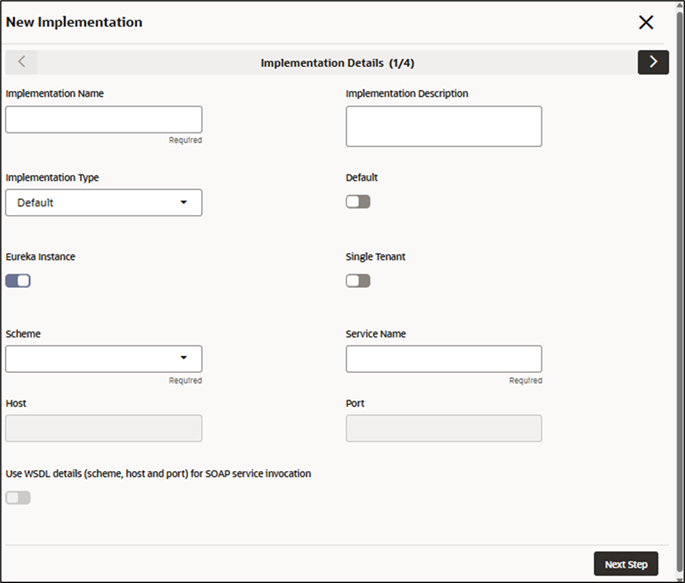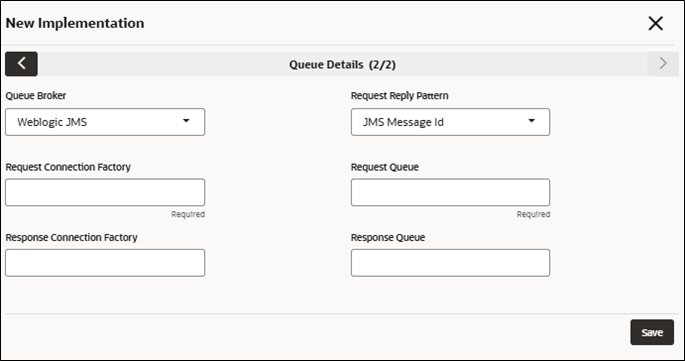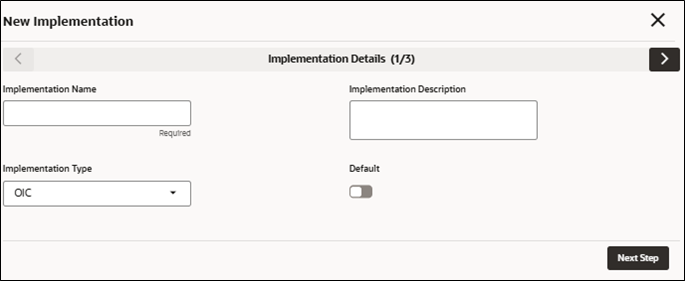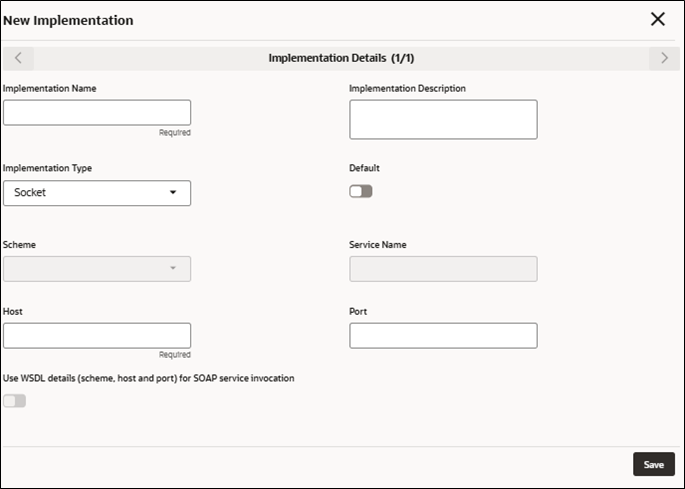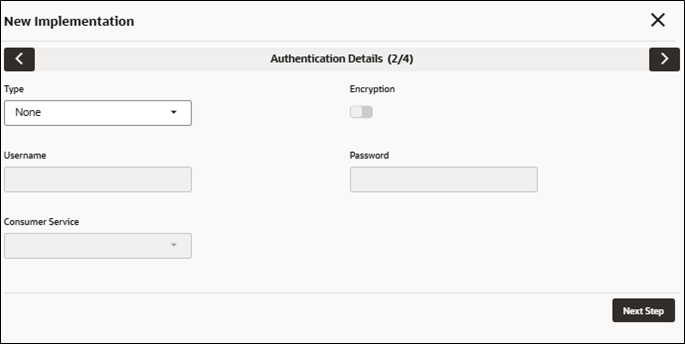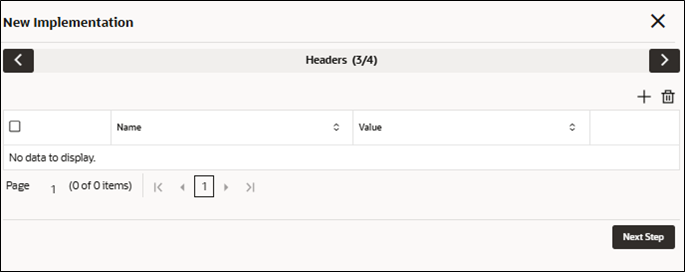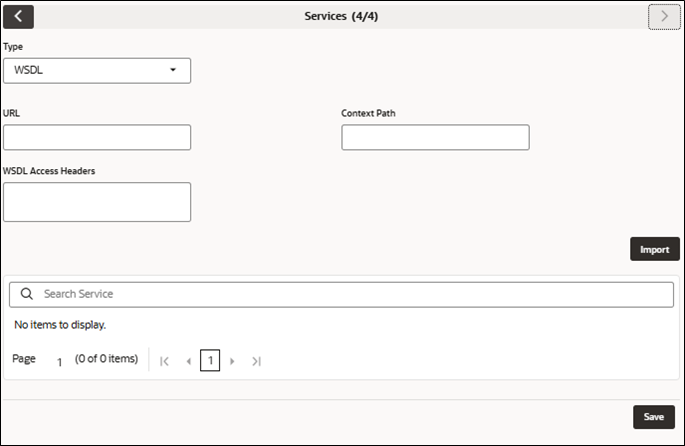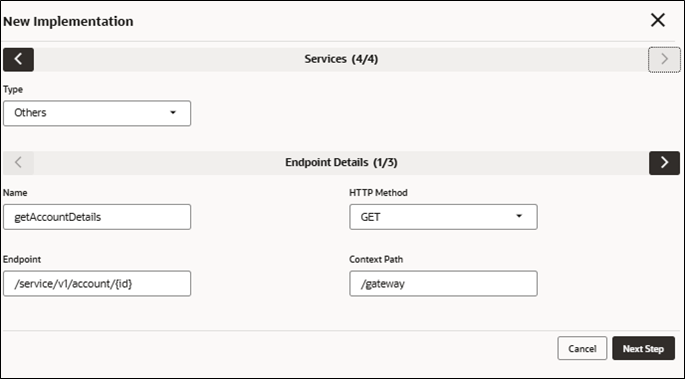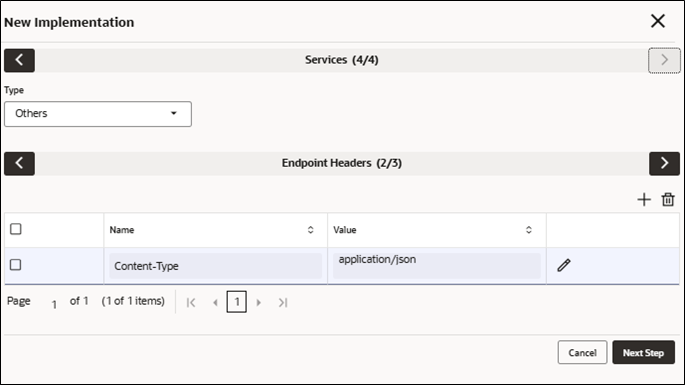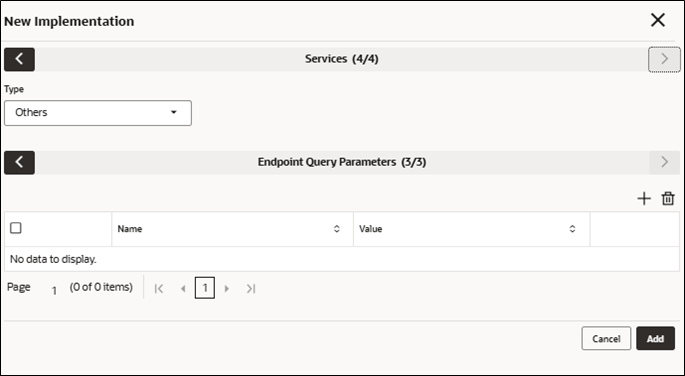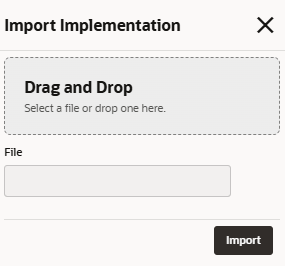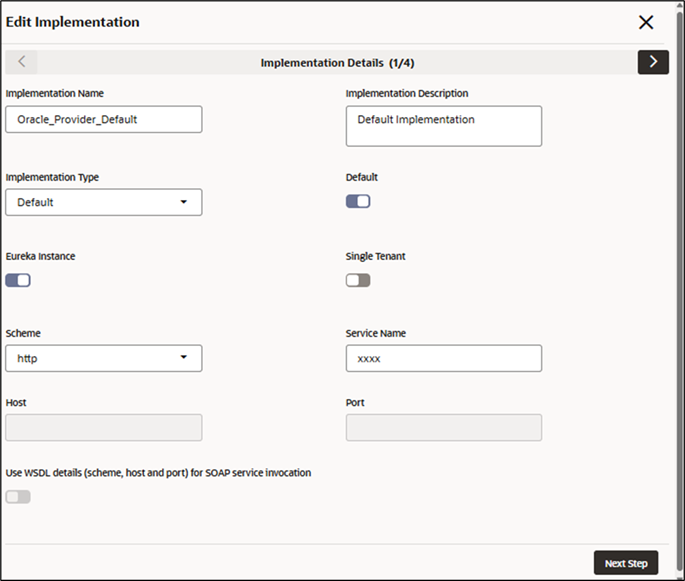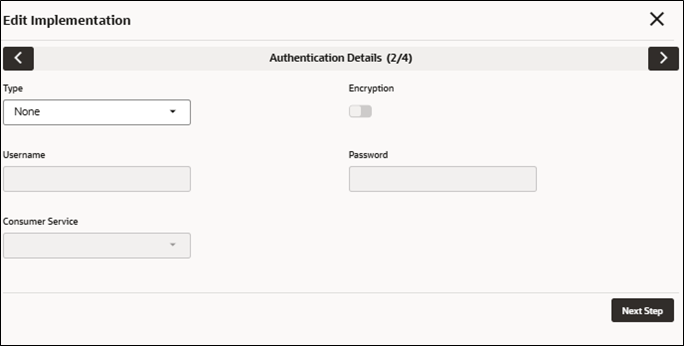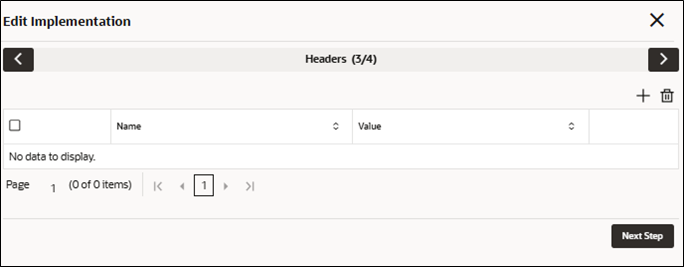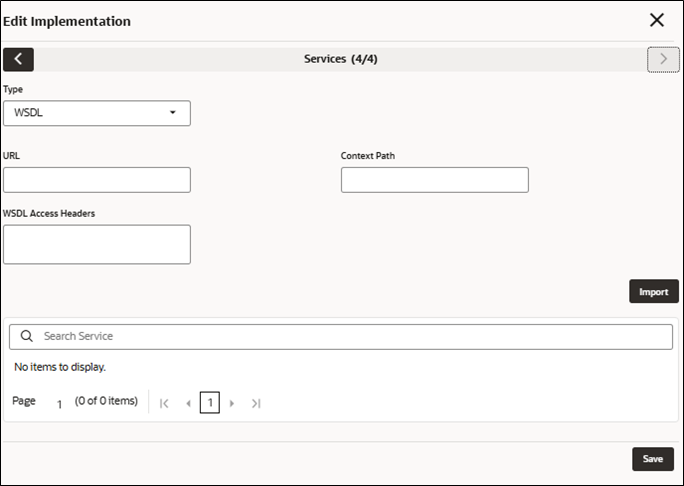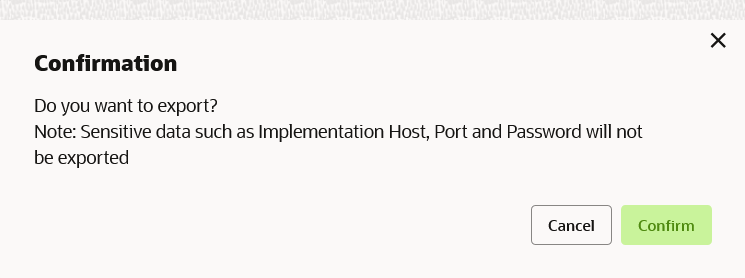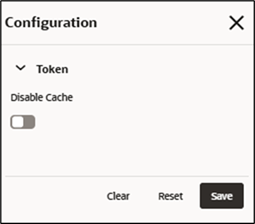5 Implementation
This topic provides the systematic instructions to configure the implementation.
Note:
Default implementation is created whenever a new service provider is added.- On Service Provider screen, click on the required service provider tile.The Implementation screen is displayed.
Implementation Details
The user can create the implementation manually.
- Click New.The New Implementation - Implementation Details screen is displayed.
Figure 5-2 New Implementation - Implementation Details
- On New Implementation - Implementation Details screen,
specify the fields.
Note:
The fields marked as Required are mandatory.For more information on fields, refer to the field description table.
Table 5-1 New Implementation - Implementation Details - Field Description
Field Description Implementation Name Specify the name of the implementation. Note:
- Enter 0 to maximum of 255 characters.
- No numeric value at beginning and no space allowed.
Implementation Description Specify the description of the implementation. Note:
- Enter 0 to 1000 characters.
- No space allowed at beginning or ending of the characters.
Implementation Type Select the type of implementation from drop-down list. The available options are:- DEFAULT
- QUEUE
- OIC
- SOCKET
- KAFKA
DEFAULT type is for REST and SOAP API calls.
Note:
The type as OIC is only applicable for cloud services.Default Toggle the button if user wants to default. Each type can have one default implementation.
Single Tenant Select the toggle to append tenant details with eureka VIP for services which are registered on eureka as single tenant services. Note:
This field is available only for internal providers and applicable only for Cloud.Eureka Instance Eureka Instance is available only for internal providers and default type.
By default, Eureka Instance will be toggled ON for internal providers and OFF for external providers.
Note:
If the Eureka Instance is toggled ON, the Api-gateway will be removed (if present) from the request URL sent to the provider. If the Eureka Instance is toggled OFF and the authentication type is selected as JWT Token or OAUTH Token, the provider request URL will include apigateway if it's missing.If the Eureka Instance is activated, it propagates the userId, branchCode, piienabled, languageCode, and locale headers from the routing hub request to the service provider request.
Scheme Select the scheme from drop-down list The available options are:- http
- https
Scheme option is available only for default type.
Service Name If Eureka Instance is toggled ON and type is default, then only service name is required. Host Specify the host. Note:
- Host cannot be blank.
- Enter 0 to 255 characters.
- Space is not allowed.
If Eureka Instance is toggled OFF and type is default, then only host and port is required.
Port Specify the port number. Note:
- Enter 0 to 6 characters.
- Enter only numeric value.
If Eureka Instance is toggled OFF and type is default, then only host and port is required.
Use WSDL details (scheme, host and port) for SOAP service This property is for using WSDL's scheme, host and port details for SOAP service invocation. Instead of using SOAP address’s scheme, host and port details appearing in WSDL. - On New Implementation screen, for adding queue
details manually, select the Implementation Type
as Queue to define the queue details.The Queue Details screen is displayed.
- Specify the fields on Queue Details
screen.
Note:
The fields marked as Required are mandatory.For more information on fields, refer to the field description table.
Table 5-2 Queue Details - Field Description
Field Description Queue Broker Select the queue broker from drop-down list. The available options are:WEBLOGIC_JMS Request Reply Pattern Select the queue broker from drop-down list. The available options are: - JMS_MESSAGEID
- JMS_CORRELATIONID
Request Connection Factory Specify the connection factory. Connection Factory is JNDI based connection factory name which is used to create connection for JMS client.
Request Queue Specify the queue. Queue Name is JNDI based destination name.
Response Connection Factory Specify the connection factory. Response Connection Factory is needed when destination is going to respond back after processing the request.
Response Queue Specify the queue. Response Queue Name is needed when destination is going to respond back after processing the request.
- On New Implementation screen, for adding queue
details manually, select the Implementation Type
as Kafka to define the queue details.The Kafka Details screen is displayed.
- Specify the fields on Kafka Details
screen.
Note:
The fields marked as Required are mandatory.For more information on fields, refer to the field description table.
Table 5-3 Kafka Details - Field Description
Field Description Topic Name Specify the topic name for publishing the message. - On New Implementation screen, for adding queue
details manually, select the Implementation Type
as OIC to define the queue details.The OIC screen is displayed.
- On New Implementation screen, for adding queue
details manually, select the Implementation Type
as Socket to define the queue details.The Socket screen is displayed.
Authentication Details
If external product processor require authentication to connect to it, Oracle Banking Routing Hub provides standard authentication mechanism schemes like Basic, JWT Token, OAuth Token, SSO, Custom.
Note:
If there is no authentication, set the Authentication Type to NONE. For identity propagation, set the Authentication Type to SSO. The token is cached for JWT Token, OAUTH_Token authentication type, and OIC Implementation Type.- Click Next Step.The New Implementation - Authentication Details screen is displayed.
Figure 5-7 New Implementation - Authentication Details
- On New Implementation - Authentication Details screen,
specify the fields.
Note:
The fields marked as Required are mandatory.For more information on fields, refer to the field description table.
Table 5-4 New Implementation - Implementation Details - Field Description
Field Description Type Select the type of authentication from drop-down list. The available options are:- Basic
- JWT Token
- OAUTH Token
- SSO
- Custom
Encryption Select the toggle to encrypt user credentials. Note:
This field is applicable only for JWT Token and OAUTH Token types.Note:
This field depends on the value of api-gateway's property "EncryptionFlag" at provider end. For more information on property value, please refer to the Oracle Banking Microservices Architecture Deployments section in Oracle Banking Microservices Platform Foundation Installation Guide.Username Specify the name of the user. Note:
- Enter 0 to maximum of 255 characters.
- No numeric value at beginning and no space allowed.
Password Specify the password. Consumer Service Select the service which will be treated as custom authentication service. Note:
Custom Authentication flag enabled consumer services are displayed
Headers
A provider implementation might require some standard headers to be passed along with the request. The user can specify the headers which are required by service endpoints but not present in swagger file.
Header step appears only if the Implementation Type is selected as Default or OIC.
Note:
Content-type header will be removed from Provider request if header value is NONE.- Click Next Step.The New Implementation - Headers screen is displayed.
- Specify the fields on the New Implementation - Headers
screen.
Note:
The fields marked as Required are mandatory.For more information on fields, refer to the field description table.
Table 5-5 New Implementation - Headers - Field Description
Field Description Name Specify the name of the header. Value Specify the value of the header. Value can be hardcoded or velocity template.
Services
- WSDL:
The Web Services Description Language (WSDL) is an XML-based interface description language that is used for describing the functionality offered by a web service.
Both SSL and non-SSL WSDL URL are supported.
Context path can be modified for existing WSDL operations.
Note:
If there is a change in wsdl file, then same wsdl file need to be imported again to update the provided service information in Routing Hub. - SWAGGER:
Swagger is an Interface Description Language for describing RESTful APIs expressed using JSON.
Currently, Swagger 2.0 and OpenAPI 3.0 both are supported.
Existing REST endpoints can also be modified or deleted.
Note:
If there is a change in swagger file, then same swagger file need to be imported again in order to update the provided service information in Routing Hub. - OTHERS:
OTHERS option is selected for adding REST API details manually when provider does not have swagger file.
Note:
If there is a change in existing endpoint, then the same endpoint details can be modified using edit option.
- Click Next Step.The New Implementation - Services screen is displayed.
- Specify the fields on the New Implementation - Services
screen.
Note:
The fields marked as Required are mandatory.For more information on fields, refer to the field description table.
Table 5-6 New Implementation - Services - Field Description
Field Description Service The below fields appear only if the Implementation Type is selected as Default or OIC. Type Select the type of service from drop-down list. The available options are:- WSDL
- SWAGGER
- OTHERS
URL Specify the service URL of the file location. Note:
This field appears only if the Type is selected as WSDL and SWAGGER.Content path Prefix Context path of below formatted URL. http://host:port/context-path/endpointGateway
WSDL Access Headers Specify the headers required for accessing / reading WSDL's. Import Click Import to extract the service information from URL and displays it in the Service list. Note:
This field appears only if the Type is selected as WSDL and SWAGGER.- On New Implementation screen, for adding REST
endpoint details manually, select the Type as
Others to define the endpoint details.The Endpoint Details screen is displayed.
- Specify the fields on Endpoint Details
screen.
Note:
The fields marked as Required are mandatory.For more information on fields, refer to the field description table.
Table 5-7 Endpoint Details - Field Description
Field Description Name Specify the name of the operation. Note:
This field appears only if the Type is selected as Others.HTTP Method Select the HTTP method from the drop-down list. The available options are:
- GET
- POST
- PUT
- PATCH
- DELETE
Note:
This field appears only if the Type is selected as Others.Endpoint URL Specify the endpoint URL for the operation. Note:
This field appears only if the Type is selected as Others.Content Path Context path of below formatted URL
http://host:port/context-path/endpoint - Click Next Step.The Endpoint Headers screen is displayed.
- Specify the fields on Endpoint Headers
screen.
Note:
The fields marked as Required are mandatory.For more information on fields, refer to the field description table.
Table 5-8 Endpoint Headers - Field Description
Field Description Name Specify the name of the header. Note:
This field appears only if the Type is selected as Others.Value Specify the value of the header. Value can be hardcoded or velocity template.
Note:
This field appears only if the Type is selected as Others. - Click Next Step.The Endpoint Query Parameters screen is displayed.
- Specify the fields on Endpoint Query Parameters
screen.
Note:
The fields marked as Required are mandatory.For more information on fields, refer to the field description table.
Table 5-9 Endpoint Query Parameters - Field Description
Field Description Name Specify the name of the header. Note:
This field appears only if the Type is selected as Others.Value Specify the value of the header. Value can be hardcoded or velocity template.
Note:
This field appears only if the Type is selected as Others. - Click Add for adding it in service list.
Import Implementation
The user can create an implementation by importing the JSON file. The user can also import zip file in order to import all the configuration JSON files together (except parent level configuration JSON files).
- On Implementation screen, click Import.The Import Implementation screen is displayed.
For more information on fields, refer to the field description table.
Table 5-10 Import Implementation - Field Description
Field Description File Click Select to select the file. Note:
Allows only to select one file and accepts JSON and ZIP file. - Click Import to import the selected file.The below data needs to be changed after importing implementation configuration file:
- Implementation Host and Port
- Implementation Authentication Password
View / Edit Implementation
The user can view or modify implementation details.
- On Implementation screen, click
Edit icon .The Edit Implementation screen is displayed.
Figure 5-14 Edit Implementation - Implementation Details
- Click Next Step.The Edit Implementation - Authentication Details screen is displayed.
Figure 5-15 Edit Implementation - Authentication Details
- Click Next Step.The Edit Implementation - Headers screen is displayed.
- Click Next Step.The Edit Implementation - Services screen is displayed.
Figure 5-17 Edit Implementation - Services
- 7. Click Save to save the modified implementation details.
Delete Implementation
The user can delete the implementation details.
- On Implementation screen, click
Delete.The Confirmation screen is displayed.
Export Implementation
The user can export the implementation configuration as JSON file.
- On Implementation screen, click Operation menu (3 dots button) and click Export.The Confirmation screen is displayed.
Figure 5-19 Confirmation - Export Implementation
Below data cannot be exported:- Implementation Host
- Implementation Port
- Implementation Authentication Password
The above data needs to be configured manually after importing the configuration file. Same has been mentioned in Import section.
Configuration
End-user can configure the properties for failing the routing hub requests.
- On Implementation tile, click Operation
menu (3 dots button), and click
Configuration.The Configuration screen is displayed. For more information on fields, refer to the field description table.
Table 5-11 Configuration - Field Description
Field Description Disable cache This property is used to disable the token caching. Note:
Default value is false.
Request Audit
- On Implementation screen, click Operation
menu (3 dots button) and click Request
Audit.The Request Audit screen is displayed.
Note:
Refer to Request Audit topic for screen and field description.
Clear Cache
The user can clear the SOAP client cache.
- On Implementation screen, click Operation menu (3 dots button) and click Clear Cache.

